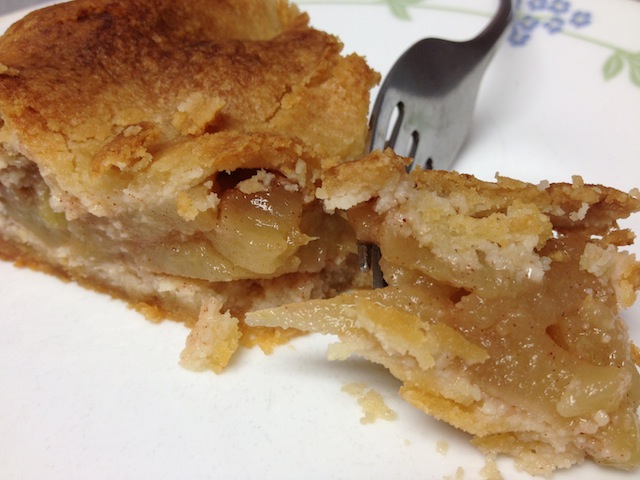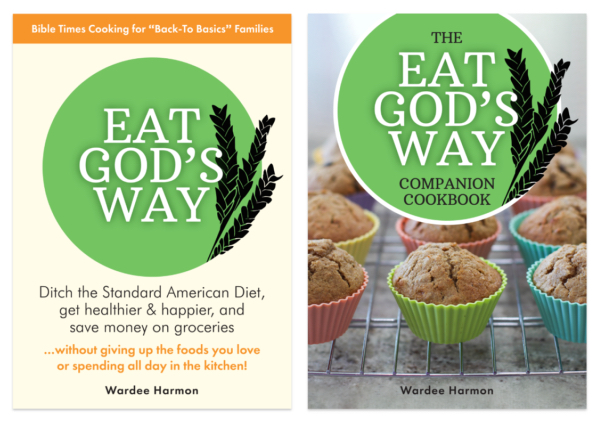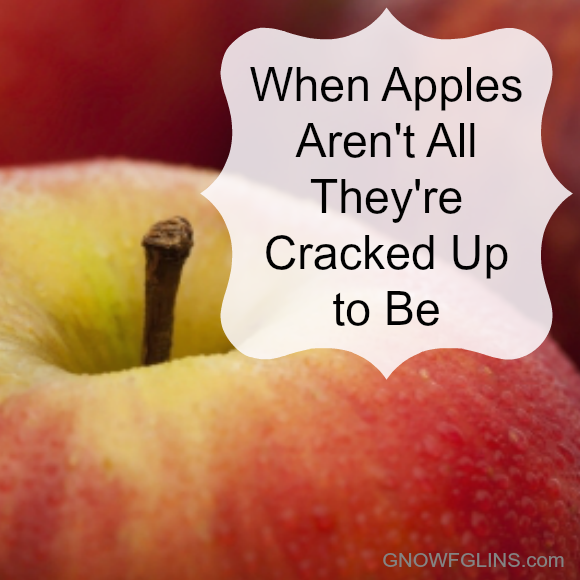Ask your doctor, your mom, and a stranger on the street if apples are healthy for you and you’ll get the same answer. Absolutely. In fact most people would look at you a little weird if you questioned it. Don’t they say, “an apple a day keeps the doctor away”?
Apples are encouraged in weight loss plans; Weight Watchers claims apples are “free”. And I’ve read more than one article encouraging you to eat three apples a day — one before each meal to “fill you up”. There’s even apple detox programs where you eat nothing but apples for days!
As moms we’re ecstatic when our kids ask for an apple as an afternoon treat instead of a cookie or a Little Debbie snack. Oh, if only grandma could hear them! Friends look at our little Red-Delicious-crunching-angels and wonder why their children can’t be like ours. Rise, oh, mothers of apple-eaters and wave at the crowds!
I hate to make your fantasy world come to a screeching halt, but here goes…
Apples Aren’t All They’re Cracked Up to Be
Let me begin by saying I’m not going to tell you that apples aren’t healthy. They contain antioxidants, fiber, vitamins, and minerals. But they’re still not always the best choice in certain situations.
What I mean is that given your normal SAD (Standard American Diet), then by all means apples are a good alternative to processed snacks and candy, but sometimes you find yourself still fighting health issues that actually discourage the eating of apples.
When Apples Aren’t Good For You
I can still remember my husband’s face when he found out he shouldn’t be eating apples — actually it was all fruit in general. “You’ve gotta be kidding me! Fruit is healthy!”
We’d just found out he had a commonly misdiagnosed problem called candida. This normally docile yeast-like fungus — which 90% of people have in their gut — grows out of control from a variety of reasons: antibiotics, a poor immune system, exposure to chemicals and pesticides/herbicides… and sugar.
Candida and Sugar
You see, candida likes sugar. A lot. And it could care less if it’s organic sugar, raw, honey, white sugar, or corn syrup. Any kind of sugar makes it do the happy dance. Including natural sugars found in fruit.
So, one of the best ways to get your candida under control is: not to eat anything with sugar. At least for a time.
After a few weeks, you can slowly start introducing a few fruits like avocados, blueberries, coconut, and green apples. Why green specifically? Because green apples tend to be more tart, which means less sugar.
But it’s not only sugar content that determines whether a fruit can be eaten. Consider this:
“When it comes to candida, the fruit/sugar debate pops up time and again. It is not necessarily the sugar content that is the deciding factor, there are other reasons that determine the fruit included in the diet of a candida patient — especially one that absolutely craves fruit.
One of the most overlooked factors is clinical experience. Once you have seen a lot of patients with candida issues, you soon work out, for example, that green (Granny Smith) apples seem to be OK with the majority, but in saying that — we are talking one apple, and not 5 or 6 a day. Many candida patients can have a tendency to be extreme in their dietary habits — it’s what got many there in the first place.
The stronger the craving, the more the need to avoid that craving.” –Dr. Eric Bakker, ND (author of Candida Crusher)
So, if staying away from apples is in your future, don’t fret. Eventually, when your candida is under control, you can eat green apples again. And then you can enjoy one of my favorite candida desserts: apple pie!
 (recipe used with permission from The Sweeter Side of Candida)
(recipe used with permission from The Sweeter Side of Candida)
You’re The Apple of My Pie
This recipe is from my brand-new eBook, The Sweeter Side of Candida. Just below the recipe, look for more information about my new book.
The Crust:
- 3 cups blanched almond flour
- 8 tablespoons cold butter OR cold coconut oil
- stevia to taste
- pinch of salt
The Filling:
- 6 Granny Smith apples, cored, peeled and sliced into 1/2 inch thick slices
- 1 tablespoon lemon juice
- 1 tablespoon arrowroot powder
- 1/2 teaspoon cinnamon
- 1/4 teaspoon nutmeg
- 1 tablespoon butter, cut into pieces
- stevia to taste
Directions:
- Preheat the oven to 450 degrees Fahrenheit.
- In a small mixing bowl, combine the crust ingredients with a pastry cutter or give it a whiz in a food processor. At first it will seem dry, but eventually it will come together until you can form it into a ball.
- Divide the pie crust dough in half. Press one of the halves into the pie plate. Roll out the other half between two sheets of lightly greased wax paper. Remove the top piece of wax paper. Set pie crust aside.
- For the filling: In a medium mixing bowl, combine apples, lemon juice, arrowroot powder, cinnamon, and nutmeg.
- Add stevia to taste — a little at a time until just a bit too sweet (the sweetness dulls when baking).
- Pour filling into unbaked pie crust. Cut up the butter into pieces and lay randomly over filling.
- Carefully lay the rolled out pie crust on top of the filling and gently peel back the wax paper. Seal edges and flute. Place pie cover over edges or cover edges with foil to prevent burning. Lightly lay a sheet of foil overtop the pie crust.
- Bake for 15 minutes. Reduce heat to 350 degrees Fahrenheit, remove sheet of foil, and bake 45 minutes longer.
- Serve warm with Whipped Coconut Cream (recipe found in The Sweeter Side of Candida) or refrigerate until later. Store leftover slices in refrigerator.
NEW eBook: The Sweeter Side of Candida
It sounds backwards, doesn’t it? Anyone with candida can tell you that sugar and starches feed candida. So how can you enjoy homemade chocolate chip cookies, multi-layered bars, luscious cheesecake, and delicious frappuccinos and still get rid of candida? Just open The Sweeter Side of Candida and chose from over 70 desserts that are totally and completely safe for anyone with candida. This cookbook is filled with over 70 delicious desserts to satisfy any sweet tooth for someone with or without candida.
This cookbook is *not* only for those who suffer from candida. It’s for anyone who wants to lose weight and/or stay healthy, too!
...without giving up the foods you love or spending all day in the kitchen!

2 free books:
Eat God's Way
Ditch the Standard American Diet, get healthier & happier, and save money on groceries...
We only recommend products and services we wholeheartedly endorse. This post may contain special links through which we earn a small commission if you make a purchase (though your price is the same).

 (
(


Hello, I’m curious as to how your husband was diagnosed with candida. Thanks for any info you can provide.
Hi Claire,
We found out by going to our naturopath. At the time we’d never even heard of it so we didn’t know about online quizzes or home test kits. If you try those, I’d recommend:
– a simple blood test you can do in the comfort of your home
– the Yeast Infection Evaluation Test – an online quiz created by Dr. Eric Bakker, ND, a naturopathic doctor who treats candida patients. You can specify the test for men, women, or children.
I guess the title was to grab peoples attention cause it grabbed mine but when I read it I thought, what? this has nothing to do with apples it’s about Candida.
Very odd.
Hello, I think your articles are great, I would like to point out something with this one in particular though. Candida Albicans are in 100% of us not just 90%, here is an article with the explanation of why they are in all of us. http://foodmatters.tv/articles-1/how-to-overcome-candida-naturally Just thought I would add 🙂 Thank you for all your hard work!
My source for saying “90% of people have in their gut” is based on the book Candida Crusher: “Candida albicans is a type of yeast like fungus that inhabits the intestines of over 90% of people as well as the genital tract and mouth of the host. In women the condition migrates readily from the large intestine to the vagina.”
I was specifying the gut, but I do agree with you. The more we discover about it, it does seem understandable that 100% of people have it when you include the whole body. 🙂
As I understand eliminting sugar doesn’t address the actual cause of candidia and at worst be harmful for some. This is an interestong article which talks about ut; http://empoweredsustenance.com/busted-candida-myths/
Interesting, thanks Guro. 🙂
Hi Guro,
Sorry for the delay in replying. The part of that article that I’m assuming you’re referring to is: “Starved candida needs sugar and so will travel upwards through the intestines in search of it. If no sugar is found, candida will project invasive filaments into the intestinal wall, pass into the bloodstream, and – if not quickly destroyed by white blood cells – become systemic.”
That post has popped up enough in conversations lately that I decided to ask Dr. Bakker, a naturopath who’s been treating candida patients for over 20 years for his opinion. This is his comment:
“What a ridiculous notion, that “candida will travel upwards in the intestine looking for food” Candida will and does lie dormant in the absence of sufficient food, it does not “starve” like the article makes out. The candida population will dwindle in the absence of food, but there is never a complete absence of food or the host would simply die, because the host needs glucose for energy needs.
Yes, Candida does like and need sugar, but eating too much (much too much) will cause a yeast proliferation if the conditions are conducive for this to occur, especially when a person drinks Coke, eats donuts, beer, white bread, Twinkies, chocolate, candy, etc, and lots of refined foods plus have been taking an antibiotic. This constitutes an amazing amount of food for Candida, and a big causative factor (the antibiotic) to boot it along.
Sugar is NOT the demon in one’s diet, it is just that when a person eats well and beyond what is considered “normal” that a yeast infection occurs, especially if there is a lot of stress and the antibiotics factored in. It’s all a question of balance, something not common in many people’s lives today.”
I hope that helps clarify it for you. 🙂
Thank you for the delicious-looking recipe! 🙂 Yum.
I also appreciate you, as a whole foods blogger, stating the truth: if people need to lose weight, deal with candida issues, or work to stabilize blood sugar levels, they also need to avoid even those natural sugars. Honey, dates, dried fruit, fruit, maple syrup, potatoes, and lots of other natural, whole foods ingredients simply do cause problems in some people.
I’ve heard some whole foods bloggers state that those who eat all whole foods, in moderation, will never be overweight. I know quite a few people, personally, in my home town, who eat 100% whole/natural foods they make at home, using a lot of the recipes and ideas found here at this site and at other whole foods bloggers’ sites, and exercise regularly, and still struggle with weight loss, candida, or pre-diabetes, even after 1+ years of eating in completely healthy ways. Some of them have eaten healthy foods and recipes for many years. This blog post hints at some of the reasons why this is the case. Thanks!
Julieanne, yes I would agree! 🙂
As someone who didn’t understand it once either – I agree! There are so many health issues out there anymore, and just eating whole foods won’t always help like we hope it will. There are often times other factors to take into consideration.
I once thought eating freshly ground homemade wheat bread smothered it in local raw honey should be the epitome of healthy eating. Boy, was I surprised when my husband found out he was allergic to gluten, honey, and had candida. 😉
Eating that way (in moderation) isn’t UNhealthy – but if you have other factors that come into play. . . .
Thanks for commenting! 🙂
This article isn’t about apples. It is sort of about candida overgrowth, but there is something that isn’t being mentioned. The root to a great many people’s problem with candida is a spirit of gluttony. Consider this. If everyone whose candida levels got out of whack would simply abstain from sugar for a time, their problem would be fixed. Sugar itself isn’t a nutrient. Our bodies can get the sugar they need from a diet that includes no sugar at all. No one who eats a whole foods diet devoid of sugar has a sugar deficit. Nearly every time that the Bible mentions drunkenness, it also mentions gluttony. My statement may come across harsh or critical, but it wasn’t meant to. I deal with sugar cravings too, and many times I give in. My only desire is to shed some light on something that has very powerful hooks. It is much easier to attack something from a physical and spiritual standpoint than to try to conquer it solely in the natural realm.
I agree with you Kerigirl, however, I personally know very careful, whole-food eating individuals who suffer from candida – those who eat veggies (starchy and non-starchy) and fruit (like apples). While these are whole foods, and good for us in general, they aren’t good if you have candida.
Thanks for sharing your thoughts – I think the majority of our health issues could be resolved by not being gluttonous. 🙂
Maybe I’m very ambitious, but I’ll be waiting for the day that we can initiate against the disease, rather than to deprive it. I believe it could only happen through medicinal herbs and foods. But till then, we’ll take what we can.
I totally agree. I think using herbs and foods for health-purposes are widely underused and under appreciated – no doubt! There are so many things we can do with herbs to help those with candida, but the other side of the coin is also avoiding (for a time) those things that encourage its overgrowth. It seems a multi-directional approach gives the best results.